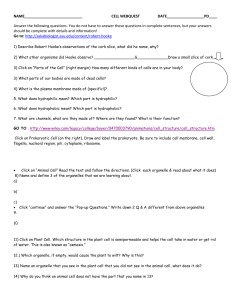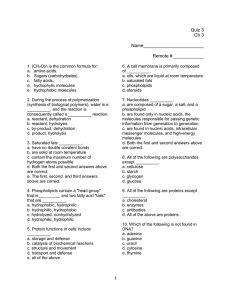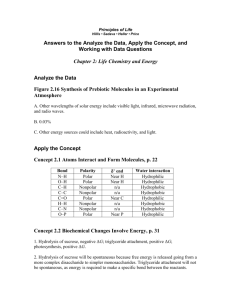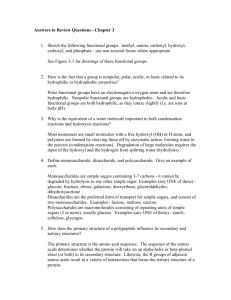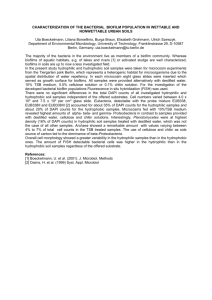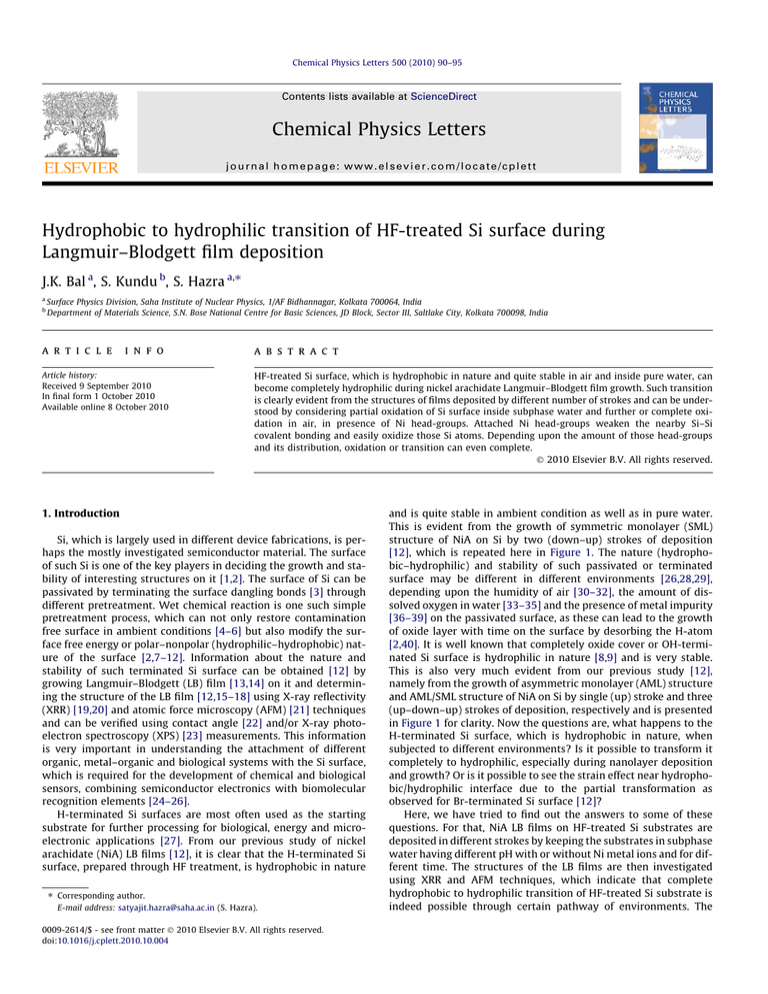
Chemical Physics Letters 500 (2010) 90–95
Contents lists available at ScienceDirect
Chemical Physics Letters
journal homepage: www.elsevier.com/locate/cplett
Hydrophobic to hydrophilic transition of HF-treated Si surface during
Langmuir–Blodgett film deposition
J.K. Bal a, S. Kundu b, S. Hazra a,⇑
a
b
Surface Physics Division, Saha Institute of Nuclear Physics, 1/AF Bidhannagar, Kolkata 700064, India
Department of Materials Science, S.N. Bose National Centre for Basic Sciences, JD Block, Sector III, Saltlake City, Kolkata 700098, India
a r t i c l e
i n f o
Article history:
Received 9 September 2010
In final form 1 October 2010
Available online 8 October 2010
a b s t r a c t
HF-treated Si surface, which is hydrophobic in nature and quite stable in air and inside pure water, can
become completely hydrophilic during nickel arachidate Langmuir–Blodgett film growth. Such transition
is clearly evident from the structures of films deposited by different number of strokes and can be understood by considering partial oxidation of Si surface inside subphase water and further or complete oxidation in air, in presence of Ni head-groups. Attached Ni head-groups weaken the nearby Si–Si
covalent bonding and easily oxidize those Si atoms. Depending upon the amount of those head-groups
and its distribution, oxidation or transition can even complete.
Ó 2010 Elsevier B.V. All rights reserved.
1. Introduction
Si, which is largely used in different device fabrications, is perhaps the mostly investigated semiconductor material. The surface
of such Si is one of the key players in deciding the growth and stability of interesting structures on it [1,2]. The surface of Si can be
passivated by terminating the surface dangling bonds [3] through
different pretreatment. Wet chemical reaction is one such simple
pretreatment process, which can not only restore contamination
free surface in ambient conditions [4–6] but also modify the surface free energy or polar–nonpolar (hydrophilic–hydrophobic) nature of the surface [2,7–12]. Information about the nature and
stability of such terminated Si surface can be obtained [12] by
growing Langmuir–Blodgett (LB) film [13,14] on it and determining the structure of the LB film [12,15–18] using X-ray reflectivity
(XRR) [19,20] and atomic force microscopy (AFM) [21] techniques
and can be verified using contact angle [22] and/or X-ray photoelectron spectroscopy (XPS) [23] measurements. This information
is very important in understanding the attachment of different
organic, metal–organic and biological systems with the Si surface,
which is required for the development of chemical and biological
sensors, combining semiconductor electronics with biomolecular
recognition elements [24–26].
H-terminated Si surfaces are most often used as the starting
substrate for further processing for biological, energy and microelectronic applications [27]. From our previous study of nickel
arachidate (NiA) LB films [12], it is clear that the H-terminated Si
surface, prepared through HF treatment, is hydrophobic in nature
⇑ Corresponding author.
E-mail address: satyajit.hazra@saha.ac.in (S. Hazra).
0009-2614/$ - see front matter Ó 2010 Elsevier B.V. All rights reserved.
doi:10.1016/j.cplett.2010.10.004
and is quite stable in ambient condition as well as in pure water.
This is evident from the growth of symmetric monolayer (SML)
structure of NiA on Si by two (down–up) strokes of deposition
[12], which is repeated here in Figure 1. The nature (hydrophobic–hydrophilic) and stability of such passivated or terminated
surface may be different in different environments [26,28,29],
depending upon the humidity of air [30–32], the amount of dissolved oxygen in water [33–35] and the presence of metal impurity
[36–39] on the passivated surface, as these can lead to the growth
of oxide layer with time on the surface by desorbing the H-atom
[2,40]. It is well known that completely oxide cover or OH-terminated Si surface is hydrophilic in nature [8,9] and is very stable.
This is also very much evident from our previous study [12],
namely from the growth of asymmetric monolayer (AML) structure
and AML/SML structure of NiA on Si by single (up) stroke and three
(up–down–up) strokes of deposition, respectively and is presented
in Figure 1 for clarity. Now the questions are, what happens to the
H-terminated Si surface, which is hydrophobic in nature, when
subjected to different environments? Is it possible to transform it
completely to hydrophilic, especially during nanolayer deposition
and growth? Or is it possible to see the strain effect near hydrophobic/hydrophilic interface due to the partial transformation as
observed for Br-terminated Si surface [12]?
Here, we have tried to find out the answers to some of these
questions. For that, NiA LB films on HF-treated Si substrates are
deposited in different strokes by keeping the substrates in subphase
water having different pH with or without Ni metal ions and for different time. The structures of the LB films are then investigated
using XRR and AFM techniques, which indicate that complete
hydrophobic to hydrophilic transition of HF-treated Si substrate is
indeed possible through certain pathway of environments. The
J.K. Bal et al. / Chemical Physics Letters 500 (2010) 90–95
91
Figure 1. XRR data (symbol) and analyzed curves (solid line) of NiA LB films on OHterminated Si substrates deposited by one and three strokes, and on H-terminated
substrate deposited by two strokes. Insets: corresponding EDPs showing the natural
hydrophilic and hydrophobic natures of the OH- and H-terminated Si substrates,
respectively [12].
mechanism behind such complete transition, which essentially
took place through partial transition (or oxidation) at each environment, is verified using contact angle and XPS measurements.
Figure 2. XRR data (symbol) and analyzed curve (solid line) of ‘high pH’ NiA LB
films on H-terminated Si substrates deposited by (a) one stroke and (b) three
strokes. Insets: corresponding EDPs showing the structures of the LB films.
2. Experiment
The details about the preparation of NiA LB films on Si substrates are discussed before [12]. In brief, arachidic acid
½CH3 ðCH2 Þ18 COOH, Sigma, 99%] molecules were spread from a
0.5 mg/ml chloroform (Aldrich, 99%) solution on Milli-Q water
(resistivity 18:2 MX cm) containing nickel sulphate (NiSO4 2H2 O,
Merck, 99%) in a Langmuir trough (Apex Instruments). The pH of
the water subphase containing 0.2 mM nickel sulphate was maintained either at ‘high pH’ (8.5–9.0) or at ‘normal pH’ (6.0–6.5) using
different amount of sodium hydroxide (NaOH, Merck, 98%). The
monolayer was compressed at a constant rate of 3 mm/min. All
depositions were done at 30 mN/m pressure and at room temperature (22 °C). Depositions were carried out at a speed of 2 mm/min
and the drying time allowed after each up stroke was 10 min.
Prior to the deposition, Si (0 0 1) substrates were made H-terminated by keeping it in a solution of hydrogen fluoride (HF,
Merck, 10%) for 3 min at room temperature after ultrasonic
cleaning in trichloroethylene (10 min) and methanol (10 min)
solution. Immediately after the HF-treatment, all the substrates
were kept inside the Milli-Q water until LB deposition. First
two NiA LB films were deposited in the ‘high pH’ condition (similar to that of 2s-NiA/H-Si sample prepared earlier [12]), one by
single (up) stroke and another by three (up–down–up) strokes,
referred as 1s-NiA/H-Si and 3s-NiA/H-Si, respectively. Two more
samples were prepared in ‘normal pH’ condition, one by single
(up) stroke and another by three (up–down–up) strokes, referred
as 1s-NiA/H-Si (NpH) and 3s-NiA/H-Si (NpH), respectively. Then
one film was prepared by single up stroke in ‘high pH’ condition
after keeping the substrate in the subphase of water for longer
time (about 90 min), referred as 1s-NiA/H-Si (LT). One further
sample was prepared by three (up–down–up) strokes in ‘high
pH’ condition, however, arachidic acid molecules were spread
Figure 3. XRR data (symbol) and analyzed curve (solid line) of ‘normal pH’ NiA LB
films on H-terminated Si substrates deposited by (a) one stroke and (b) three
strokes. Insets: corresponding EDPs showing the structures of the LB films.
92
J.K. Bal et al. / Chemical Physics Letters 500 (2010) 90–95
on the trough only before final up stroke, referred as 1s-NiA/H-Si
(2sNi). The films prepared before [12] were also used for
comparison.
XRR measurements were carried out using a versatile X-ray diffractometer (VXRD) setup to investigate the structure of deposited
NiA LB films. VXRD consists of a diffractometer (D8 Discover, Bruker AXS) with Cu source (sealed tube) followed by a Göbel mirror
to select and enhance Cu Ka radiation (k ¼ 1:54 Å). The diffractometer has a two-circle goniometer ðh—2hÞ with quarter-circle Eulerian cradle as sample stage. The latter has two circular and three
translational motions. Scattered beam was detected using NaI scintillation (point) detector. Data were taken in specular condition, i.e.
the incident angle ðhÞ is equal to the reflected angle ðhÞ and both
are in a scattering plane. Under such condition, a non-vanishing
wave vector component, qz , is given by ð4p=kÞ sin h with resolution
1
0:0014 Å .
The topography of the LB fllms on HF-treated Si substrates
were mapped through AFM technique (beam-deflection AFM,
Omicron NanoTechnology) in different length scales and in different portions of the samples, after completion of XRR measurements. AFM images were collected in noncontact mode and in
UHV ð 109 mbarÞ conditions to minimize the tip induce modification of the soft films and to get clean images, respectively.
WSXM software [41] was used for image processing and
analysis.
To verify the hydrophilic or hydrophobic nature of the Si
surface treated differently, contact angle measurements using
home built setup were carried out. 4 ll of water was placed on
the treated Si surface using Hamilton syringe and the shape of
the water droplet was captured by a traveling microscope followed by a digital camera. To know the chemical nature of the
Si surface after treatment and after LB film deposition, XPS measurements of four different samples were performed in a multiprobe chamber (Omicron NanoTechnology) equipped with an
Al Ka ðE ¼ 1486:6 eVÞ source and a hemispherical analyzer (EA
125).
3. Results and discussion
3.1. X-ray reflectivity and electron-density profile
XRR technique essentially provides an electron density profile
(EDP), i.e. in-plane ðx—yÞ average electron density ðqÞ as a function
of depth ðzÞ in high resolution [40]. From EDP it is possible to estimate the structure of a film and by knowing the structure (AML or
SML) just above the substrate one can predict the nature (hydrophobic or hydrophilic) of the substrate [12]. To obtain the EDP,
XRR data has been analyzed using Parratt’s formalism [42] and
for the analysis, each film has been divided into a number of layers
including roughness at each interface.
XRR data and analyzed curves of 1s-NiA/H-Si and 3s-NiA/H-Si
samples are shown in Figure 2. It can be noted that XRR profile
of 1s-NiA/H-Si sample (Figure 2a) is different from that of 1sNiA/OH-Si sample (Figure 1), while XRR profile of the 3s-NiA/HSi sample (Figure 2b) is quite similar to that of 3s-NiA/OH-Si sample (Figure 1). This is also clear from the EDPs shown in the insets
of Figures 1 and 2. EDPs suggest that for 1s-NiA/H-Si sample, the
structure is AML + SML, i.e. both AML and SML structures are present side-by-side, in nearly equal ratio, on the substrate, while for
3s-NiA/H-Si sample, the structure is AML/SML, i.e. only AML structure is present on the substrate. The AML and SML which are present in 3s-NiA/H-Si sample are quite perfect (straight and compact),
while those in 1s-NiA/H-Si sample are imperfect (tilted and
jumbled).
XRR data and analyzed curves of 1s-NiA/H-Si (NpH) and 3s-NiA/
H-Si (NpH) samples are shown in Figure 3. EDPs obtained from the
analysis are shown in the insets of Figure 3. Both XRR curve and
EDP (Figure 3a) for 1s-NiA/H-Si (NpH) sample are similar to those
of 1s-NiA/H-Si sample (Figure 2a), and so the corresponding structure. However, for the single stroke ‘normal pH’ sample, the coverage of SML structure is greater than that of AML structure, unlike
‘high pH’ one. For 3s-NiA/H-Si (NpH) sample, both XRR curve and
EDP (Figure 3b) are quite different from those of 3s-NiA/H-Si
Figure 4. AFM images (of scan size 1 1 lm2 ) showing topography of different pH NiA LB films on H-terminated Si substrates deposited by different strokes. (a) ‘High pH’
three strokes, (b) ‘normal pH’ three strokes, (c) ‘high pH’ one stroke and (d) ‘normal pH’ one stroke. Presence of layers of different heights (in unit of AML length) are indicted
by the numbers.
93
J.K. Bal et al. / Chemical Physics Letters 500 (2010) 90–95
sample (Figure 2b). The structure of three strokes ‘normal pH’ sample is AML + AML/SML. Although, SML structure is not found on the
substrate, the coverage of first layer with AML is quite low and the
coverage with AML/SML structure is even lower.
Analysis of the XRR curves of 1s-NiA/H-Si (LT) and 1s-NiA/H-Si
(2sNi) samples (not shown here) suggest that the structures of
both films are AML + SML. Although, the area corresponding to
AML structure on the substrate is slightly greater than that of
SML one, the surface is never completely covered with AML
structure.
3.2. Atomic force microscopy and topography
Typical AFM images of four LB films are shown in Figure 4. The
topography of 3s-NiA/H-Si sample (Figure 4a) is quite smooth and
compact. Considering the XRR result, the height can be assigned to
3 (in unit of AML length), corresponding to the AML/SML structure.
Domains of different heights, namely 0, 1 and 3 corresponding to
substrate, AML and AML/SML structures are clearly visible in the
AFM image of 3s-NiA/H-Si (NpH) sample (Figure 4b), consistent
with XRR result. The topography of 1s-NiA/H-Si and 1s-NiA/H-Si
(NpH) samples (Figure 4c and d) are quite similar. Both seems to
compose of domains of two different heights and considering the
XRR results, the heights can be assigned to 1 and 2, corresponding
to the AML and SML structures. The fact that the height difference
between two such structures is less than 1 nm, is the imperfect
nature of the films, as predicted by XRR.
3.4. Hydrophobic–hydrophilic transition mechanism
H-terminated Si surface is hydrophobic in nature, while OH-terminated Si surface is hydrophilic in nature. So, in principle, the
mechanism behind hydrophobic to hydrophilic transition is very
simple, conversion of H-terminated surface to OH-terminated
one. However, the questions are – when and how such conversion
take place, i.e. what are the parameters responsible for such conversion? It is known that depending upon the sequence of deposition of LB films, substrate needs to place either inside subphase
water (for odd number of stroke) or outside subphase water, i.e.
in air (for even number of stroke) for about 30 min, until the pressure of Langmuir monolayer reached to a constant value of 30 mN/
m to transfer. In air mainly oxygen interacts with the HF-treated
surface whereas in solution apart from the dissolved oxygen many
2þ
ions like OH ; SO2
4 ; Ni , etc. are there which may interact with the
passivated surface. Although native oxide grows on the passivated
Si surface in ambient condition by desorbing the passivating element, the oxide growth rate depends on the passivating element.
For H-passivated Si surface, the oxide growth rate in air is such that
very little oxide or hydrophilic area could grow in 30 min. On the
OH-terminated
Si substrate after HF- treatment
H-terminated Si: Hydrophobic
Outside subphase water
Inside subphase water
i.e. in air for ~30 min
for ~30 min
3.3. Hydrophobic–hydrophilic transition pathway
Structures of the NiA LB films on HF-treated Si substrates
deposited by different number of strokes and their stability obtained from XRR and AFM results, provide the hydrophobic to
hydrophilic transition pathway, which is shown schematically in
Figure 5. SML structured NiA LB film is formed on H-terminated
Si surface by two (down–up) strokes of deposition (i.e. in 2s-NiA/
H-Si sample), which almost remains unchanged in air. This is a
clear signature of stable hydrophobic nature of the H-terminated
Si surface. On the other hand, AML + SML structured NiA LB film
is formed on HF-treated Si surface by single (up) stroke of deposition (i.e. in 1s-NiA/H-Si, 1s-NiA/H-Si (NpH) and 1s-NiA/H-Si (LT)
samples). This indicates partial conversion of hydrophobic surface
to hydrophilic one, inside subphase water. The ratio between the
coverage of AML and SML structures increases with the pH of the
subphase water and with the duration for which the substrate
was inside it, indicating increase in conversion with those two
parameters. However, never completed with AML structure in such
single stroke of deposition, unlike 1s-NiA/OH-Si sample, implying
that the hydrophobic to hydrophilic transition of the HF-treated
Si surface inside subphase water is always partial.
AML + AML/SML structured LB film, with partial coverage is
formed on HF-treated Si surface by three (up–down–up) strokes
of deposition in ‘normal pH’ condition (i.e. in 3s-NiA/H-Si (NpH)
sample). Although, SML structure is not formed on the substrate,
the hydrophilic nature of the substrate is only partial. The film
formed on HF-treated Si surface by three (up–down–up) strokes
of deposition in ‘high pH’ condition (i.e. 3s-NiA/H-Si sample), however, shows AML/SML structure similar to that of 3s-NiA/OH-Si
sample. It can be noted that for the 1s-NiA/H-Si (2sNi) sample,
where only last up stroke is through Langmuir monolayer, the
structure is neither AML/SML or complete AML. That means complete hydrophilic nature of the HF-treated Si surface is observed
for the NiA LB film deposited in ‘high pH’ condition and in three
stokes, all through Langmuir monolayer.
H-terminated
Si substrate
Modified
Si
Almost no change
NiA deposition by down-up stroke
Partial change, pH dependent
NiA deposition
by up stroke
NiA LB
film on Si
Mainly SML structure
Si = Hydrophobic
In air
Imperfect AML + SML structure
Si = Hydrophobic + hydrophilic
In air
Modified
NiA/Si
Mainly SML structure
Si = Remains hydrophobic
Imperfect AML + SML structure
Si = Transforming to hydrophilic
Further NiA
deposition by down-up stroke
H-terminated: hydrophobic
High pH subphase water
+
Attached Ni head and air
+
High pH subphase water
OHOH-terminated: hydrophilic
Mainly AML/SML structure
Si = Transformed to hydrophilic
Figure 5. Schematics of the structures of NiA LB films on HF treated Si substrates
deposited by different number of strokes and the process involved for hydrophobic
to hydrophilic transition of corresponding Si surface. SML structure on Si substrate:
hydrophobic nature corresponding to H-terminated Si surface, AML or AML/SML
structure on Si substrate: hydrophobic nature corresponding to OH-terminated Si
surface and in between AML and SML mixed structure corresponding to H- and OHterminated mixed Si surface.
94
J.K. Bal et al. / Chemical Physics Letters 500 (2010) 90–95
other hand, partial and complete hydrophilic transition of H-passivated Si surface in subphase water and in 3s-NiA/H-Si film are
due to the growth of oxide on the Si surface. Since the amount of
dissolved oxygen is much less in the subphase water compared
to that in air, chemical reactions must take place under subphase
water and there after in air for the growth of oxides on Si surface,
which needs understanding.
3.4.1. Partial transition
The possible conversion mechanism of the H-terminated Si surface to OH-terminated one, through oxide formation, in subphase
of water [8,9,43] is shown pictorially in Figure 6. When H-terminated Si substrate is immersed into subphase water, H atoms are
replaced by OH groups to form Si–OH (silanol) groups, according
to the following reaction.
Si—H þ Hþ þ OH ¼ Si—OH þ H2
Due to the strong electronegativity of OH group, the charge induces
to the Si atom bonded directly to it ðd þ þÞ is more compared to the
next one ðdþÞ. This polarization weaken the Si–SiOH back bond. In
the next step, water molecules or dissolved Hþ and OH ions attack
that back bond to form Si–H and Si–OH as given below.
Si
dþþ
—Si
dþ
þ Hþ þ OH ¼ Si—H þ Si—OH
Si–H bond is further replaced by OH group to form Si–OH. When
two such neighboring OH groups face each other then oxide is
formed through a bridging reaction.
Si—OH þ Si—OH ¼ Si—O—Si þ H2 O
In this way, OH-terminated oxide layer is formed on the Si substrate
under subphase water. It is necessary to mention that such reaction
hardly occur for Br-terminated Si surface, which is evident from the
similar structure for two LB films (deposited either by up stroke or
by down–up strokes) on Br-terminated Si surface [12]. Due to the
higher electronegativity of Br atom (2.96) compared to that of H
atom (2.20) [44], OH group could not replace the former one easily
as they do the latter one. Even for H-terminated Si surface, such
reaction rarely takes place in pure water. Presence of different ions,
mainly OH ions in subphase water essentially helps such reaction.
The coverage of OH-terminated oxide layer on the Si surface increases with the pH of the subphase water and with the duration
for which the substrate was inside it, but never complete or full.
Accordingly, hydrophobic to hydrophilic transition is only partial.
However, is there exists any limiting value for such partial transition, similar to that observed for Si surface using selective surface-chemistry route [45], is not clear and need further
experimental and theoretical studies.
H
OH
H
Si
Si
(
OH
)
(
)
OH
H2
H
Si
Si
(
OH
Si
(
)
OH
Si
H
)
Si
OH
Si
Si
OH
OH
H2
Si
Si
OH
O
Si
Si
Si
H
OH
Si
OH
Si
H
OH
Si
Si
Figure 6. Possible conversion mechanism of Si surface under subphase water: from
H-terminated to OH-terminated oxide.
3.4.2. Complete transition
Complete hydrophobic to hydrophilic transition occurs in air
due to the presence of Ni head groups on partially transformed Si
surface. It is known that the presence of some metals on the Si surface can create instability [46,47] and enhance the oxidation rate of
Si in air [36–39]. This is because the underlying Si–Si covalent
bonds are weaken in presence of those metals (or metal ions)
and accordingly associated Si atoms readily react with the ambient
oxygen to form native oxide layer. In the partially transformed Si
surface, AML structure is formed on hydrophilic portion and SML
structure is formed on hydrophobic portion. That means Ni head
groups are attached to the oxide (hydrophilic) portion of the surface and those head groups, although connected with the carboxylic ligands through ionic bonding, weaken the nearby Si–Si
covalent bonding by crossing the H-passivated layer and thereby
increasing the oxide coverage in air. It can be noted that such Si–
Si bond weaken may not occur through Br-passivated layer because of its large size (1.14 Å) and/or bond length with Si
(2.15 Å) compared to those of H (0.37 and 1.48 Å, respectively)
[44]. Since this conversion took place near the attached Ni portion,
the final coverage of oxide layer depends on the amount of attached Ni and its distribution on the Si surface. This is in agreement
with our results. For the 1s-Ni/H-Si (2sNi) sample, probably very
2þ
few Ni ions were physisorbed on Si surface in first up stroke,
which limits the formation of OH-terminated oxide layer in air.
The formation of OH-terminated oxide layer is not even complete
in subsequent subphase water, which is evident from the final
structure of the film (i.e. from the partial coverage with AML structure). For the films deposited in single up stroke and in two pH
conditions, the number of Ni head groups attached to the Si surface
and hence the formation of oxide layer in air are considerable.
Among those two films, the number of Ni head groups attached
to the Si surface is more for the film prepared in ‘high pH’ condition
and correspondingly, the OH-terminated oxide layer in air is nearly
complete. Although, complete hydrophilic nature of HF-treated Si
surface we observed for 3s-Ni/H-Si sample, the complete transition
essentially occur in air after first up stroke of deposition, as discussed. The fact that the structure of the 1s-Ni/H-Si sample do
not change completely to SML with time, because in air the change
in the configuration of molecules is very difficult. Subphase water
in subsequent deposition can however change the structure
through reorganization (or configurational change) of NiA molecules, as observed.
3.4.3. Direct evidence
The proposed mechanism for hydrophobic to hydrophilic transition of HF-treated surface is well supported by contact angle
and XPS measurements. Contact angles for HF-treated Si surface
(referred as H-Si) and RCA cleaned Si surface (referred as OH-Si)
are found to be 79 and 14 17 , respectively. These correspond
to hydrophobic and hydrophilic natures of H-Si and OH-Si, respectively [48]. Contact angle for H-Si substrate after keeping it inside
NiSO4 solution for about 40 min [referred as H-Si (sol)] is 34 .
This suggests that the surface of H-Si (sol) becomes hydrophilic
compared to H-Si substrate but less hydrophilic compared to
OH-Si substrate. That means inside NiSO4 solution, OH-terminated
hydrophilic spots grow on H-terminated hydrophobic matrix,
making overall substrate partially hydrophilic.
The Si 2p core-level XPS spectra of H-Si, H-Si (sol), 1s-NiA/H-Si
and 3s-NiA/H-Si samples are shown in Figure 7. XPS spectra for
first two samples were collected just after preparation, while those
for latter two samples were collected after performing all XRR
0
measurements. The peak at 99:5 eV represents Si chemical
4þ
state, while that at 103:4 eV represents Si chemical state, corresponding to silicon (Si) substrate and silicon oxide ðSiO2d Þ layer,
respectively [49,50]. It is necessary to mention that the spectra in
J.K. Bal et al. / Chemical Physics Letters 500 (2010) 90–95
95
of view, is only visible after subsequent deposition, i.e. after reorganization of molecules under subphase water.
Acknowledgments
The authors thank Prof. M. Mukherjee and Mr. A.K.M. Maidul Islam for their help in XPS measurements and Prof. S. Banerjee and
Ms. A. Bhattacharya for their help in contact angle measurements.
References
Figure 7. XPS spectra of four different samples in the Si 2p binding energy region.
Two peaks appear due to substrate (Si) and surface or interfacial oxide layer
ðSiO2d Þ, are indicated.
0
Figure 7 are presented after normalizing each spectrum with its Si
peak intensity. Presence of silicon oxide in the H-Si sample is not
observed, while that in other three samples is clearly evident. This
indicates that the surface of H-Si sample is well passivated with H
atoms and is stable in air, at least for the time, before it transfer
into the UHV chamber. It can be noted that for the 2s-NiA/H-Si
sample, this was the substrate condition when deposition of NiA
molecules starts and complete hydrophobic nature of such is quite
natural. The oxide signal for 1s-NiA/H-Si and 3s-NiA/H-Si samples
are quite strong and nearly similar, while that for H-Si (sol) is relatively weak. Latter indicates that the oxide growth on the surface
of H-Si (sol) sample is only partial. This was the substrate condition
for the 1s-NiA/H-Si sample when deposition starts and partial
hydrophilic and hydrophobic natures of such substrate is well expected. XPS spectrum of 1s-NiA/H-Si sample clearly shows that
further oxide really grows at the film–substrate interface of such
sample with time in air and is nearly complete (comparing with
the XPS spectrum of 3s-NiA/H-Si sample) as proposed, although
not much structural change is observed.
4. Conclusions
HF-treated Si surface, which is hydrophobic in nature and quite
stable in air, transformed partially or completely to hydrophilic
surface, inside subphase water or during NiA LB film growth by
up–down–up strokes of deposition and in ‘high pH’ condition. This
transition essentially takes place by conversion of H-terminated Si
surface to OH-terminated one, through oxide formation. Although
the amount of oxygen inside subphase water is less compared to
that in air, the oxide formation inside subphase water is more,
which takes place by chemical reaction in presence of highly electronegative OH ions. As the pH of the subphase water increases,
the amount of OH ions increases and so the amount of oxide coverage. Also, as the duration for which the substrate was inside subphase water increases, the chances of chemical reaction increases
and so the amount of oxide coverage, but never complete or full.
The attachment of Ni head groups on the oxide portion of the partially transformed Si substrate by deposition of LB film, essentially
weaken the nearby Si–Si bonding, which then readily react with
oxygen to form oxides. It is observed that depending upon the
amount of attached Ni head groups and its distribution on the Si
surface, it is possible to have complete oxide coverage through
such reaction in air. The signature of which, from structural point
[1] J.A. Zasadzinski, R. Viswanathan, L. Madsen, J. Garnaes, D.K. Schwartz, Science
263 (1994) 1726.
[2] J.K. Bal, S. Hazra, Phys. Rev. B 79 (2009) 155412.
[3] V. Derycke, P.G. Soukiassian, F. Amy, Y.J. Chabal, M.D. D’Angelo, H.B. Enriquez,
M.G. Silly, Nat. Mater. 2 (2003) 253.
[4] H. Ubara, T. Imura, A. Hiraki, Solid State Commun. 50 (1984) 673.
[5] E. Yablonovitch, D.L. Allara, C.C. Chang, T. Gmitter, T.B. Bright, Phys. Rev. Lett.
57 (1986) 249.
[6] V.A. Burrows, Y.J. Chabal, G.S. Higashi, K. Raghavachari, S.B. Christman, Appl.
Phys. Lett. 53 (1988) 998.
[7] V.A. Shchukin, D. Bimberg, Rev. Mod. Phys. 71 (1999) 1125.
[8] F. Okorn-Schmidt, IBM J. Res. Dev. 43 (1999) 351.
[9] X.G. Zhang, Electrochemistry of Silicon and Its Oxide, Kluwer Academic, New
York, 2004.
[10] C.-Y. Ruan, V.A. Lobastov, F. Vigliotti, S. Chen, A.H. Zewail, Science 304 (2004)
80.
[11] P.L. Silvestrelli, F. Toigo, F. Ancilotto, J. Phys. Chem. B 110 (2006) 12022.
[12] J.K. Bal, S. Kundu, S. Hazra, Phys. Rev. B 81 (2010) 045404.
[13] K.B. Blodgett, I. Langmuir, Phys. Rev. 51 (1937) 964.
[14] M.C. Petty, Langmuir–Blodgett Films, An Introduction, Cambridge University,
New York, 1996.
[15] D.K. Schwartz, Surf. Sci. Rep. 27 (1997) 245.
[16] J.K. Basu, S. Hazra, M.K. Sanyal, Phys. Rev. Lett. 82 (1999) 4675.
[17] J.K. Basu, M.K. Sanyal, Phys. Rep. 363 (2002) 1.
[18] S. Kundu, A. Datta, S. Hazra, Chem. Phys. Lett. 405 (2005) 282.
[19] I.K. Robinson, D.J. Tweet, Rep. Prog. Phys. 55 (1992) 599.
[20] J. Daillant, A. Gibaud (Eds.), X-ray and Neutron Reflectivity: Principles and
Applications, Springer, Paris, 1999.
[21] S. Morita, R. Wiesendanger, E. Meyer (Eds.), Noncontact Atomic Force
Microscopy, Springer, Heidelberg, 2002.
[22] K.L. Mittal (Ed.), Contact Angle, Wettability and Adhesion, VSP BV, Urecht,
Netherlands, 1993.
[23] J.F. Watts, J. Wolstenholme, An Introduction to Surface Analysis by XPS and
AES, Wiley, 2003.
[24] T. Strother, W. Cai, X. Zhao, R.J. Hamers, L.M. Smith, J. Am. Chem. Soc. 122
(2000) 1205.
[25] K.-Y. Tse, B.M. Nichols, W. Yang, J.E. Butler, J.N. Russell, R.J. Hamers, J. Phys.
Chem. B 109 (2005) 8523.
[26] M. Dai, Y. Wang, J. Kwon, M.D. Halls, Y.J. Chabal, Nat. Mater. 8 (2009) 825.
[27] R. Boukherroub, Curr. Opin. Solid State Mater. Sci. 9 (2005) 66.
[28] X. Zhang, E. Garfunkel, Y.J. Chabal, S.B. Christman, E.E. Chaban, Appl. Phys. Lett.
79 (2001) 4051.
[29] S. Rivillon, F. Amy, Y.J. Chabal, M.M. Frank, Appl. Phys. Lett. 85 (2004) 2583.
[30] M. Niwano, J. Kageyama, K. Kurita, K. Kinashi, I. Takahashi, N. Miyamoto, J.
Appl. Phys. 76 (1994) 2157.
[31] T. Ohmi, J. Electrochem. Soc. 143 (1996) 2957.
[32] E.S. Snow, G.G. Jernigan, P.M. Cambell, Appl. Phys. Lett. 76 (2000) 1782.
[33] Y.J. Chabal, S.B. Christman, Phys. Rev. B 29 (1984) 6974.
[34] M. Ranke, Y.R. Xing, Surf. Sci. 157 (1985) 339.
[35] E. Kondoh, M.R. Baklanov, F. Jonckx, K. Maex, Mater. Sci. Semicond. Process. 1
(1998) 107.
[36] T. Hanada, M. Kawai, Vacuum 41 (1990) 650.
[37] D. Graf, M. Grundner, D. Muhlhoff, M. Dellith, J. Appl. Phys. 69 (1991) 7620.
[38] S. Xu, P. Xu, M. Ji, X. Liu, M. Ma, J. Zhu, Y. Zhang, J. Mater. Sci. Technol. 9 (1993)
437.
[39] N. Takano, N. Hosoda, T. Yamada, T. Osaka, Electrochim. Acta 44 (1999) 3743.
[40] J.K. Bal, S. Hazra, Phys. Rev. B 75 (2007) 205411.
[41] I. Horcas, R. Fernndez, J.M. Gwez-Rodrguez, J. Colchero, J. Gomez-Herrero, A.M.
Baro, Rev. Sci. Instrum. 78 (2007) 013705.
[42] L.G. Parratt, Phys. Rev. 95 (1954) 359.
[43] D. Graf, M. Grundner, R. Chulz, J. Vac. Sci. Technol. A 7 (1989) 808.
[44] J.K. Bal, S. Hazra, Defect Diffus. Forum 297–301 (2010) 1133.
[45] D.J. Michalak, S.R. Amy, D. Aureau, M. Dai, A. Esteve, Y.J. Chabal, Nat. Mater. 9
(2010) 266.
[46] A. Hiraki, Surf. Sci. Rep. 3 (1983) 357.
[47] J.K. Bal, S. Hazra, Phys. Rev. B 79 (2009) 155405.
[48] S. Adachi, T. Arai, K. Kobayashi, J. Appl. Phys. 80 (1996) 5422.
[49] F.J. Himpsel, F.R. McFeely, A. Taleb-Ibrahimi, J.A. Yarmoff, G. Hollinger, Phys.
Rev. B 38 (1988) 6084.
[50] A. Pasquarello, M.S. Hybertsen, R. Car, Phys. Rev. B 53 (1996) 10542.

